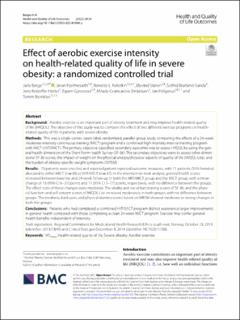| dc.contributor.author | Berge, Jarle | |
| dc.contributor.author | Hjelmesæth, Jøran Sture | |
| dc.contributor.author | Kolotkin, Ronette Loganzo | |
| dc.contributor.author | Støren, Øyvind | |
| dc.contributor.author | Bratland-Sanda, Solfrid | |
| dc.contributor.author | Hertel, Jens Kristoffer | |
| dc.contributor.author | Gjevestad, Espen Svendsen | |
| dc.contributor.author | Småstuen, Milada Cvancarova | |
| dc.contributor.author | Helgerud, Jan | |
| dc.contributor.author | Bernklev, Tomm | |
| dc.date.accessioned | 2022-08-02T08:45:30Z | |
| dc.date.available | 2022-08-02T08:45:30Z | |
| dc.date.created | 2022-03-07T10:50:25Z | |
| dc.date.issued | 2022 | |
| dc.identifier.citation | Berge, J., Hjelmesæth, J., Kolotkin, R. L., Støren, Ø., Bratland-Sanda, S., Hertel, J. K., Gjevestad, E., Småstuen, M. C., Helgerud, J. & Bernklev, T. (2022). Effect of aerobic exercise intensity on health-related quality of life in severe obesity: a randomized controlled trial. Health and Quality of Life Outcomes, 20, Artikkel 34. | en_US |
| dc.identifier.issn | 1477-7525 | |
| dc.identifier.uri | https://hdl.handle.net/11250/3009730 | |
| dc.description.abstract | Background: Aerobic exercise is an important part of obesity treatment and may improve health-related quality of life (HRQOL). The objective of this study was to compare the effect of two different exercise programs on health-related quality of life in patients with severe obesity.
Methods: This was a single-center, open-label, randomized, parallel-group study comparing the effects of a 24-week moderate-intensity continuous training (MICT) program and a combined high-intensity interval training program with MICT (HIIT/MICT). The primary objective (specified secondary outcome) was to assess HRQOL by using the general health dimension of the Short Form Health Survey (SF-36). The secondary objectives were to assess other dimensional SF-36 scores, the impact of weight on the physical and psychosocial aspects of quality of life (IWQOL-Lite), and the burden of obesity-specific weight symptoms (WRSM).
Results: 73 patients were enrolled and reported patient reported outcome measures, with 71 patients (55% females) allocated to either MICT (n = 34) or HIIT/MICT (n = 37). In the intention-to-treat analysis, general health scores increased between baseline and 24-week follow-up in both the HIIT/MICT group and the MICT group, with a mean change of 13 (95% CI 6–21) points and 11 (95% CI 5–17) points, respectively, with no difference between the groups. The effect sizes of these changes were moderate. The vitality and social functioning scores of SF-36, and the physical function and self-esteem scores of IWQOL-Lite increased moderately in both groups, with no difference between groups. The tiredness, back pain, and physical stamina scores based on WRSM showed moderate to strong changes in both the groups.
Conclusions: Patients who had completed a combined HIIT/MICT program did not experience larger improvements in general health compared with those completing a clean 24-week MICT program. Exercise may confer general health benefits independent of intensity. | en_US |
| dc.language.iso | eng | en_US |
| dc.rights | Navngivelse 4.0 Internasjonal | * |
| dc.rights.uri | http://creativecommons.org/licenses/by/4.0/deed.no | * |
| dc.title | Effect of aerobic exercise intensity on health-related quality of life in severe obesity: a randomized controlled trial | en_US |
| dc.type | Peer reviewed | en_US |
| dc.type | Journal article | en_US |
| dc.description.version | publishedVersion | en_US |
| dc.rights.holder | © The Author(s) 2022. | en_US |
| dc.source.pagenumber | 10 | en_US |
| dc.source.volume | 20 | en_US |
| dc.source.journal | Health and Quality of Life Outcomes | en_US |
| dc.identifier.doi | https://doi.org/10.1186/s12955-022-01940-y | |
| dc.identifier.cristin | 2007966 | |
| dc.source.articlenumber | 34 | en_US |
| cristin.ispublished | true | |
| cristin.fulltext | original | |
| cristin.qualitycode | 1 | |

